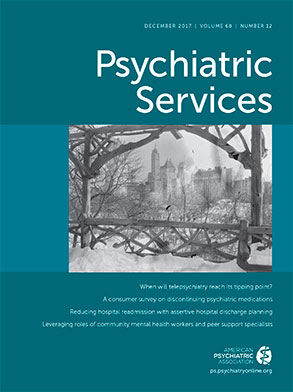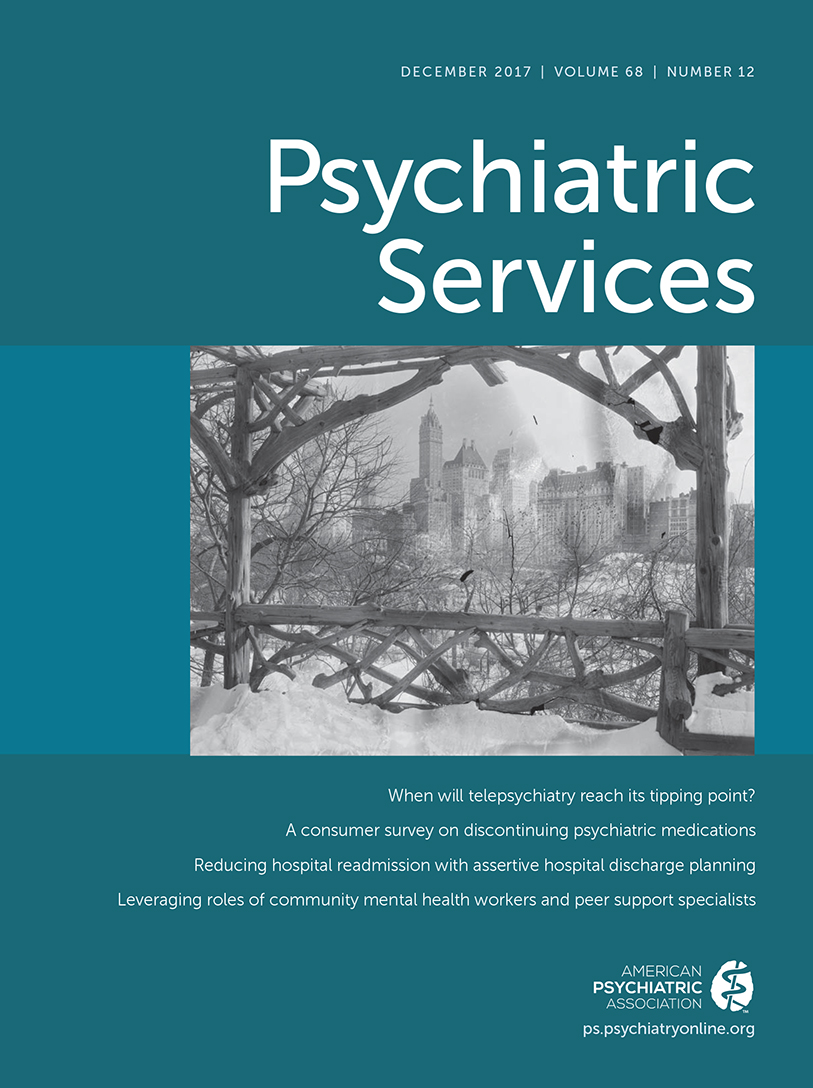Health care organizations have increasingly emphasized the importance of patient-centered care, or care that the Institute of Medicine has defined as “respectful of and responsive to individual patient preferences, needs, and values” and that ensures that “patient values guide all clinical decisions” (
1). For many patients experiencing illness, these individualized values are strongly influenced by religious and spiritual considerations (
2). In health care organizations, the professionals most specialized to attend to patients’ religious and spiritual needs are chaplains. Given the growing scientific literature demonstrating significant, meaningful, and complex interrelationships among religion, spirituality, and mental health functioning (
3), development of integrated systems of mental health and chaplain care that can be dynamically responsive to patients’ diverse needs is clinically and ethically important.
Background
In 2010, the U.S. Department of Veterans Affairs (VA) and the Department of Defense (DoD) jointly commissioned a large-scale mixed-methods review of chaplains’ roles with respect to mental health care as part of VA/DoD Integrated Mental Health Strategy (IMHS). The departments initiated IMHS at a time when many post-9/11 service members were beginning to leave the military and enter the VA system. This was an opportune time to coordinate the approach to a range of mental health issues facing veterans and service members. The focus on chaplains’ roles was one of a total of 28 different strategic actions launched by the departments as part of IMHS, and the aim of this specific strategic action was to conduct a “gap analysis” that assessed the current state of chaplaincy integration with mental health care and propose a more optimal future state.
The gap analysis was informed and interpreted with the help of a 38-member task group composed of mental health professionals, chaplains, and researchers from various levels (leadership and clinicians) across VA, DoD, and outside organizations. A survey of all full-time VA chaplains and all active duty DoD chaplains was conducted (N=2,163), as was a series of site visits to 33 medical facilities across VA and DoD, where 201 mental health professionals and 195 chaplains participated in hour-long interviews. Findings from this project indicated that chaplains frequently saw veterans and service members with mental health problems (
4) and that there was substantial room for improving integration of care services, with providers often being interested in improved integration of these services (
5).
Recommendations from the mixed-methods assessment included providing broad cross-disciplinary education about the value of integration, developing an in-depth mental health subspecialization training program for chaplains, and equipping leaders and clinicians at local facilities to champion and facilitate systems redesign efforts focused on improved integration. These three recommendations were the basis of a VA/DoD Joint Incentive Fund (JIF) proposal, and the project was funded and began in 2013. We describe here the third of these three recommendations, which utilized a learning collaborative model to help teams of mental health professionals and chaplains implement quality improvements.
Learning Collaborative Model
The Breakthrough Series learning collaborative model was first popularized in health care by the Institute for Healthcare Improvement in the late 1990s. It has since been used as a key mechanism for spreading innovations in VA (
6–
8). The model used in our collaborative included six improvement domains—screening, referrals, assessment, communication and documentation, cross-disciplinary training, and role clarification. [A table in the
online supplement further describes each aim.] These domains received focus in three two-day learning sessions spread over the course of seven months. Each learning session was followed by an action period for teams to implement and monitor their improvements. [A figure in the
online supplement depicts the learning collaborative model and process.] During the action periods, teams implemented systems improvements using plan-do-study-act (PDSA) cycles. PDSA cycles involve developing an improvement idea (plan), implementing it (do), evaluating it (study), and then using the data to inform next steps (act) (
6–
8). Teams were not necessarily expected to develop and implement aims in all six domains. Instead, teams received assistance with mapping current processes at their facilities and in using that information to determine areas most in need of improvement.
Securing Participation
Seven of the 14 teams were from VA facilities. These teams were invited to participate on the basis of recommendations from national VA chaplain leadership, findings from recent IMHS site visits to many of VA facilities, knowledge of potential willingness to participate, and enhancement of geographic diversity. The seven DoD teams were selected primarily from U.S. military medical facilities—three Army, three Navy, and one Air Force—and were designated to participate by appropriate military service–level leadership in mental health and chaplaincy, who had been informed about the intentions of the collaborative. The process of securing participation was more challenging in DoD than in VA, likely owing to DoD’s three distinct branches that needed to be engaged and to DoD being less locally empowered to make decisions compared with VA, necessitating socialization with multiple layers of leadership.
Each facility’s core team consisted of a credentialed mental health professional and a chaplain, with each team assigned a quality improvement coach (an expert in learning collaborative and systems improvement methods but not in the topical area). Quality improvement coaches provided logistical, systemic, and motivational support to teams and were supervised by the Veterans Engineering Resource Center leadership team, which also provided industrial engineers, systems redesign expertise, and resources throughout the collaborative. Teams were geographically dispersed across the United States, most were located at large medical centers, and improvement efforts were focused across a range of clinical settings: posttraumatic stress disorder clinics were most common for VA teams, and outpatient mental health settings were most common in DoD [see online supplement].
Evaluation
Evaluation in the learning collaborative consisted of teams monitoring their progress toward individualized goals in PDSA improvement cycles and of surveys administered at baseline and post-collaboration that targeted all mental health professionals and chaplains at participating sites. All evaluation activities were certified as nonresearch quality improvement activities that adhered to both VA and DoD regulations.
Improvement cycles.
To track progress toward their goals as part of each PDSA cycle, each team developed individualized metrics, such as number of patients per month in a particular mental health clinic who were referred to chaplaincy (or vice versa), number of local educational training sessions held, or percentage of patients in a mental health clinic who screened positive for spiritual distress (and percentage of those who accepted a referral to chaplaincy). Teams also were encouraged to engage in improvement efforts in domains that related to the particulars of their setting, and larger local integration objectives. Teams successfully completed 76 PDSA cycles across all six collaborative domains, devoting the most effort in the domains of screening (17 cycles), referrals (17 cycles), and role clarification (17 cycles), followed by communication and documentation (13 cycles), cross-disciplinary training (nine cycles), and assessment (three cycles). [The online supplement shows a PDSA cycle example from one site.]
Surveys.
To evaluate potential spread of integrative mental health–chaplaincy practices from learning collaborative teams’ selected clinical settings to their broader facilities, baseline and post-collaboration electronic surveys were sent to the broader base of mental health providers (at least all psychiatrists and psychologists; social workers and others could be included depending on the mental health service makeup at a facility) and chaplains at facilities participating in the learning collaborative. Surveys evaluated perceptions of integration across the six quality improvement domains from the learning collaborative model. Compared with baseline, by post-collaboration, mental health professionals at participating facilities were significantly more likely to report using a routine process to identify patients who could benefit from chaplain services (p=.01), regularly communicating with chaplains to improve patient care (p=.01), having a clear understanding of how the disciplines can collaborate (p=.02), and having opportunities for joint training with chaplains when appropriate (p=.001). Post-collaboration, chaplains at participating facilities were significantly more likely to report having a clear understanding of how the disciplines can collaborate (p=.01) but less likely to report benefiting from reading mental health providers’ notes (p=.03), and there was a trend for chaplains to be more likely to report using a routine process to identify patients who could benefit from seeing a mental health professional (p=.05) [see online supplement].
Lessons Learned
The domains in which teams invested the most effort, including screening and role clarification, tended to be the areas in which facilities were most likely at the broader service line levels (entire chaplain service or mental health service at a facility) to show post-collaborative improvement. Follow-up analyses that separately considered data from VA and DoD teams indicated that the aims of the learning collaborative could be successfully implemented across both VA and DoD in a manner that promoted replication across the broader services at participating facilities. VA teams showed somewhat more pronounced gains (or lack of difficulty) in a few key areas, for two possible reasons. First, VA teams were identified earlier and had a longer start-up period than DoD teams. Second, VA teams generally tended to have more autonomy than DoD teams to independently initiate change within their health care facilities.
An important attribute of this learning collaborative was that teams were strongly encouraged to formalize systematic changes from their quality improvement efforts within care coordination agreements. By the end of the collaborative, all teams either had such agreements signed by the heads of their mental health and chaplaincy departments or were working on accomplishing this. These agreements included articulating such things as how the disciplines would refer patients to one another, collaborate on interdisciplinary care teams, and conduct cross-disciplinary training. Findings from the IMHS site visits indicated that key persons (for example, chaplains who initiated collaborations with mental health providers) were often responsible for integrative mental health and chaplaincy practices in the few places where this existed, and it was therefore easy for clinical integration to disintegrate along with staffing changes. Hence, particularly in military contexts where changes in duty assignments are routine, establishing care coordination agreements that are regularly revisited is important to ensure maintenance of systematic improvements.
Conclusions
Mental health and chaplain services are often not well integrated within health care organizations, but findings from this study indicate that intentionally focusing quality improvement efforts in key domains can bring about improvements in how these clinical care services are organized and interact. Because these disciplines often intersect very little in officially structured capacities within many health care environments, initial efforts should focus on establishing the necessary foundations. Clarifying identities and services that the disciplines can provide, initiating even semistructured efforts for identifying and screening patients that may benefit from seeing someone in the other discipline, and providing a clear framework for making referrals are good foundational practices from which to launch other collaborative endeavors (such as jointly led groups). Ultimately, such efforts can lead to more patient-centered care and improved outcomes.

